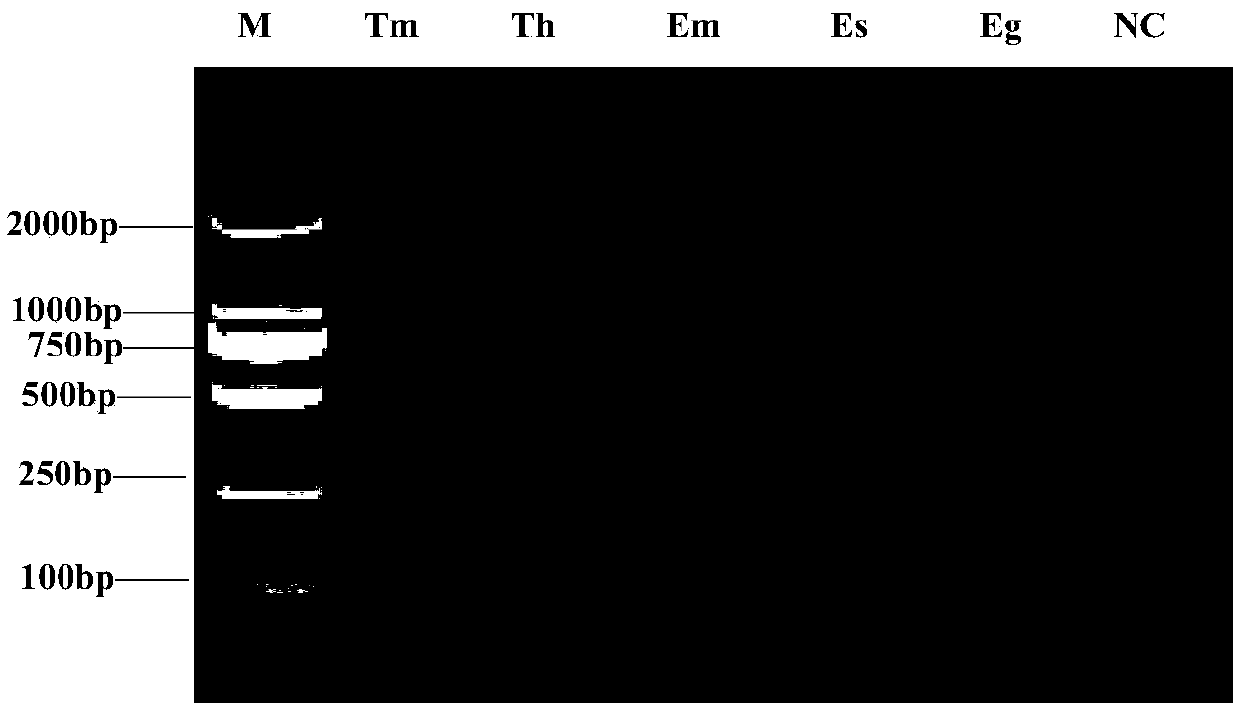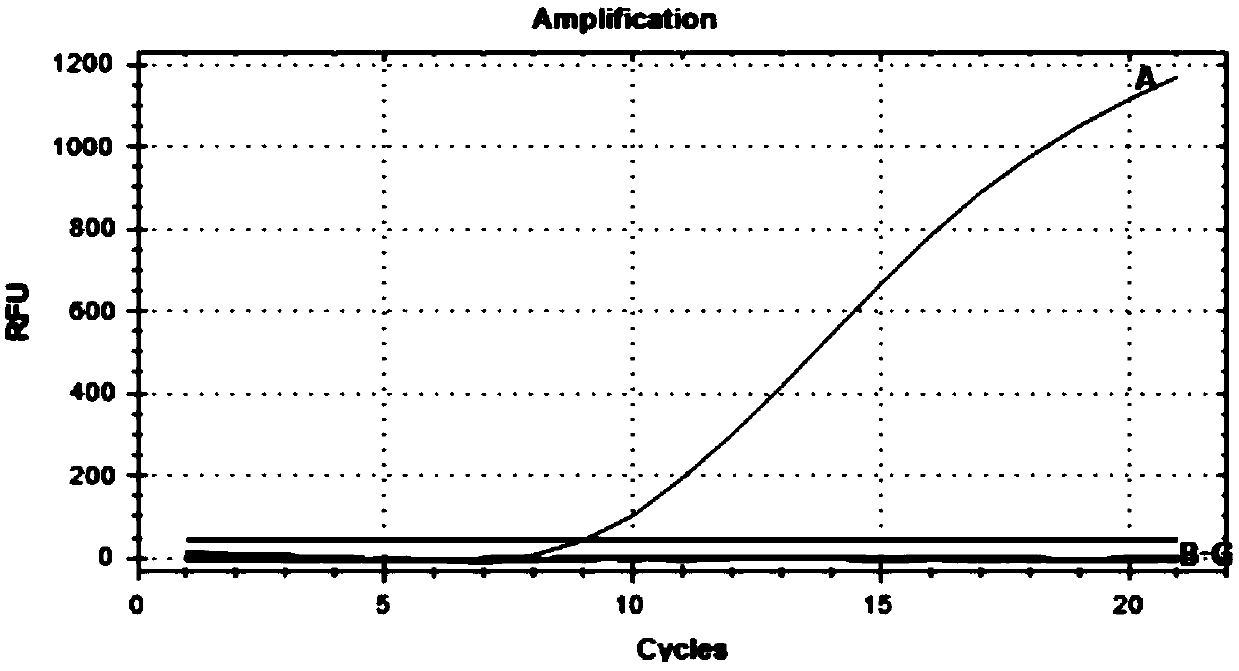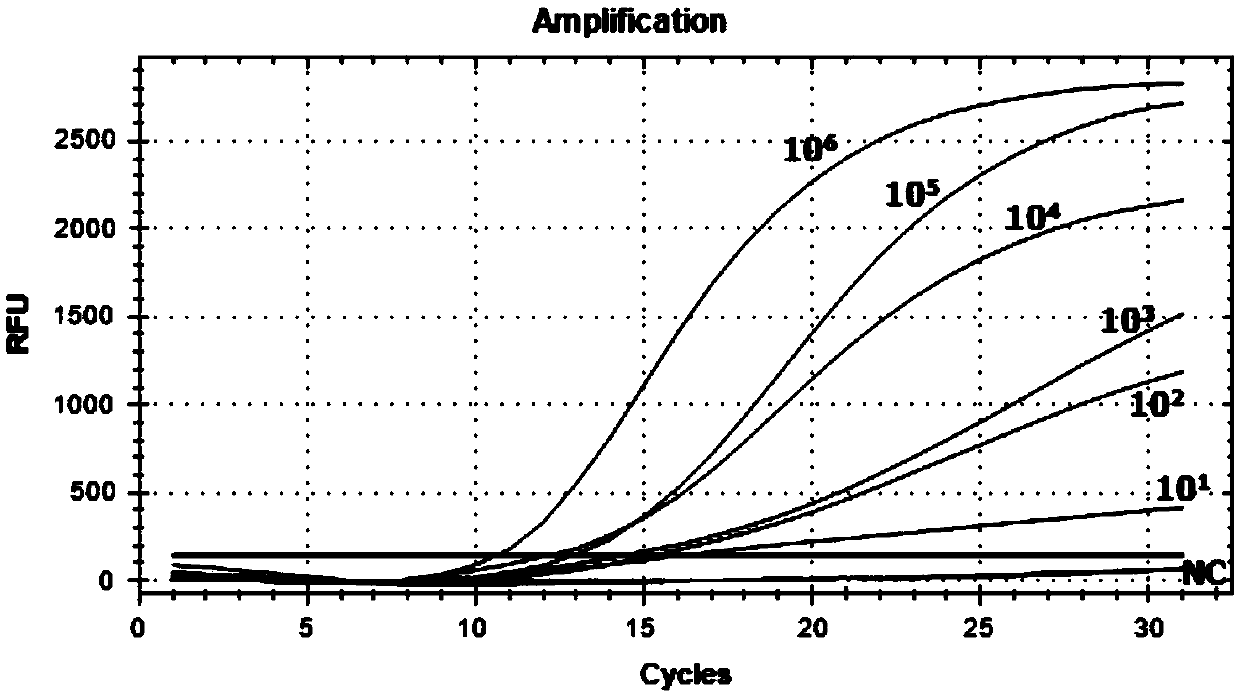Echinococcus shiquicus detection kit based on RPA technology and application of echinococcus shiquicus detection kit
A technology of Echinococcus shiqu and reagents, which is applied in the field of Echinococcus shiqu detection kits, can solve problems such as the application of RPA technology that has not been seen, and achieve the effects of short reaction time, strong specificity and high sensitivity
- Summary
- Abstract
- Description
- Claims
- Application Information
AI Technical Summary
Problems solved by technology
Method used
Image
Examples
Embodiment 1
[0079] Example 1. RPA primers and probes for detecting Echinococcus shiquense and its detection method
[0080] 1. RPA primers and probes for the detection of Echinococcus shiquense
[0081] 1. Obtain the sequence information of the target gene
[0082] The partial sequence of the whole mitochondrial genome of Echinococcus shiquense was used as the detection target gene, according to the complete mitochondrial genome sequence of Echinococcus shiquense (NC_009460) and other common tapeworms with canines as their final hosts in the GenBank database [GenBank accession no.NC_014768 (Tenia zoster, Taenia taeniaeformis), GU569096 (Taenia lentilis), NC_021145 (Pipipyra canis), GQ228818 (Tenia polycephalum), GQ228819 (Tenia alveolar), NC_009460 (Echinococcus shiqu tapeworm), AB786664 (Echinococcus granulosus), KU601616 (Echinococcus granulosus), NC_000928 (Echinococcus multilocularis), AB208063 (Echinococcus canadensis G6), AB235848 (Echinococcus canadensis G8), AB745463 ( Echinococ...
Embodiment 2
[0112] Embodiment 2, the specific fluorescent RPA detection method of Echinococcus shiquense
[0113] Using the genomic DNA of Taenia polycephala, Taenia alveolar, Taenia lentiformis, Echinococcus multilocularis, Echinococcus granulosus and Echinococcus shiqueri as templates, using SEQ ID No.2 and SEQ ID No.3 The primer uses Es-b-probe3 as the probe, and performs specific fluorescent RPA detection according to the instructions of the RPA kit Basic exo, and uses a fluorescent quantitative PCR instrument for signal detection. The detailed operation steps are as follows:
[0114] ① Prepare the following reagents: upstream primer (10 μmol / L) 2.1 μL, downstream primer (10 μmol / L) 2.1 μL, Es-b-probe (10 μmol / L) 0.6 μL, Rehydration buffer 29.5 μL, template (genome) 1 μL, ddH 2 O 12.2 μL was added to a 1.5mL centrifuge tube, and vortexed to mix;
[0115] ② Add 47.5 μL of the reaction system to the freeze-dried reaction reaction tube in the kit, and mix well by blowing up and down wi...
Embodiment 3
[0124] Example 3, Sensitivity analysis of Echinococcus shiqu specific fluorescent RPA detection
[0125] 1. Construction of plasmid standards
[0126] ①Using the genomic DNA of Echinococcus shiquense as a template, the Es-T-F and Es-T-R primers were used for ordinary PCR amplification to obtain the target fragment shown in SEQ ID No.1. The primer sequences are as follows:
[0127] Es-T-F: 5'-TAGTGTGATGATGGTTTTGA-3' (SEQ ID No.10);
[0128] Es-T-R: 5'-CACACACCCAAAATCAGTAC-3' (SEQ ID No. 11).
[0129] The PCR amplification reaction system (total volume 50 μL) is as follows: 1 μL upstream primer, 1 μL downstream primer, 25 μL Ex Taq premixed enzyme, 2 μL template (genome), ddH 2 O 21 μL.
[0130] The PCR amplification reaction procedure was as follows: first, fully pre-denature at 98°C for 5 min; then 35 cycles, respectively: denaturation at 95°C for 30 s; annealing at 56°C for 30 s; extension at 72°C for 50 s, and finally extension at 72°C for 10 min.
[0131] ②Purify and r...
PUM
 Login to View More
Login to View More Abstract
Description
Claims
Application Information
 Login to View More
Login to View More - R&D
- Intellectual Property
- Life Sciences
- Materials
- Tech Scout
- Unparalleled Data Quality
- Higher Quality Content
- 60% Fewer Hallucinations
Browse by: Latest US Patents, China's latest patents, Technical Efficacy Thesaurus, Application Domain, Technology Topic, Popular Technical Reports.
© 2025 PatSnap. All rights reserved.Legal|Privacy policy|Modern Slavery Act Transparency Statement|Sitemap|About US| Contact US: help@patsnap.com



